ADAPTING TO THE ELASTICITY OF A LANDSCAPE
(Re)discover the work of the artist collective de Onkruidenier through the article that was part of Living Body/ies, Circostrada's first annual red-thread publication.
Would it be possible for a map of the coast to show the rhythm of the tides? When we use our hands, feet or other tools to draw lines in the surf, we sit comfortably with the thought that each one will be washed away soon. When you spend an entire day at the beach, the cadence of the tides completely redefines your surroundings every six or so hours. Open Google Maps and visit the location of your favourite coast: what do you see? A clear border between yellow and blue, land and water. This image does not show the elasticity of the coastal landscape, or how it perpetually breathes in and out together with the tides. Where can we find this elasticity in our daily surroundings, and how might we perform it along the coast? In June 2022, artist collective de Onkruidenier arranged a session of nine performative trainings on the coast of the island Terschelling, during the OEROL festival. Together with our audience, we explored elasticity as an embodied concept, we activated our vocal cords and taste buds while moving through the porous zone between land and sea. This way, we performed the release and tension of this coastal ‘border’. In conversations and discussions with the audience, a number of experts in a wide range of fields and a stubborn local nature conservation group, all the different lessons learned at OEROL tangled together in one performative search for elasticity.
Since 2013, de Onkruidenier has been performing artistic research into the potentials of transforming ecologies. How do we, as humans, adapt to our surrounding landscape, instead of the other way around? Landscapes have the ability to shape our knowledge, cultures and languages. This is why parts of our landscapes can be found within ourselves: the memory of our bodies might still contain knowledge about our environment. Our dive into this collective memory has given shape to the research project SWEET – SWEAT. The Netherlands is a large delta where many areas have been transformed from wet to dry land, or from salt to sweet water bodies. These transformations form a part of both our history and daily life – so, what could they look like as a part of our future? As a new chapter for SWEET – SWEAT, we developed a participatory training to be performed with 25 participants. Each day of the OEROL festival we entered a wadden-beach (Wadden Sea is an intertidal zone in the south eastern part of the North Sea) named the ‘Kleiplak’ (clay deposit) next to the dike. Here, during low tide, we would perform four exercises together. For de Onkruidenier, the intimacy of activating an audience in such a direct manner is central to our practice. The authority of the singular artist makes place for the artist collective, which opens itself up to participants during each performance. Exploring the relationship between body and landscape becomes a collective activity, where knowledge is embodied instead of transferred in a linear way.
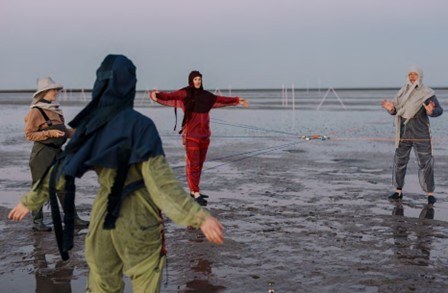
The training worked as follows: first, the audience was introduced to the landscape by mapping their own location. After the explicit instruction to leave behind ‘economic clock time’ and replace it with the circadian rhythm for an hour and a half, we trekked towards the beach together. Where have we landed? To answer this question, participants would have to go further than just observe the immediate environment. With our ears, we tapped into the different layers of the landscape. What do we hear below, or above us? And what does the sand tell us where it lays beneath our hands? Participants were given a chalk and a board, to draw a horizon and orient themselves and the sounds they heard around it. This first part became a collective listening exercise, where we attempted to break up the traditional signifiers of language that we use to guide us through landscapes. What body part does the wad sound like? And what shape do we imagine these different noises to take on? After listening and drawing together, the second part of the training led the group away from the dry sandy dune, further out on the wad, with most walking barefoot. This is where the exploration of elasticity truly started. After an introduction on different Frysian words for defining a landscape (a language which is also spoken on Terschelling), participants received a piece of elastic the size of their own body length, that we tied in a loop to use as a ‘tool.’ Now that we had listened to the landscape together, the next step was to produce a collective sound inspired by the wad. In the Frysian language, the vowels I, A and O often occur in words that signify a specific type of landscape. Each of these sounds connect to a space in the landscape: From high IIIIII’s reaching to the sky, to wide OOOO’s opening our hands at the ocean and low AAAAA’s moving downwards connecting to the wad. Using the elastic as a tool to visualise and project our vocal cords, we started making sounds together. The group transformed into one polyphonic organism, while the elastics vibrated in the gusts of wind. Together, voices and elastic projected IIIIII’s, AAAAA’s and OOOO’s.
Following this vocal exercise, we led the group further out onto the wad and connected everyone’s elastics to a smaller elastic tool. This way, the audience was physically attached to one another, and had to react or anticipate each other’s movements. By connecting the lung capacity of the group, we simultaneously breathed and walked together, casting shadows of jellyfish or octopus-like creatures onto the wet sand with our elastic ‘tentacles’. Collectivity was the only way to complete the exercise: the groups performed an organism, entangled with each other and the landscape. Finally, arriving back on dryer land, we tasted a miniature perspective on the landscape together. What do you taste when you internalise your environment with locally foraged ingredients? We not only asked what the audience tasted, but also where in their mouth their taste buds were activated. With this training, the relationship between body and landscape became upended. The projection of our voices and our listening exercise amidst the salty air of the wad made us notice other things. How bubbles escape the clay as an escape of breath, for example. Instead of imitating the movements and sounds of the environment individually, it was important for the audience to truly perform the landscape together. By allowing entanglements between the group to take place, the ways in which different ‘actors’ of the ecosystem surrounding the group tangled together became much clearer.
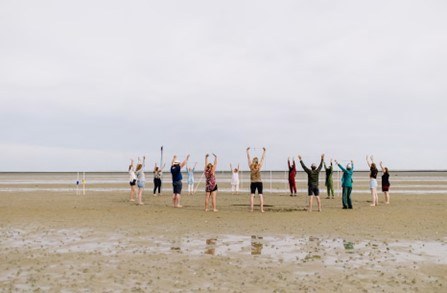
Instead of transferring knowledge, the main aim of the training was to collectively embody the intertidal zone. We made use of different tools in a spatial installation that referred to the tides of the water. In different colour schemes and heights, rows of wooden poles were installed in the wad, meandering through the landscape. The tone and length of the poles referred to the different time zones that the tide moves through between its highest and lowest point. This way, when passing through the installation on a ‘wad-walk’, one can relate their own body to the respiration of the sea. The colour scheme is a response to the stringent use of the baseline coastline, which uses purple, green, orange and pink to mark the separation between land and the saline water. Of course, translating these markings from the two-dimensional X and Y axis of the coastal policy into the actual landscape is futile. When walking past the installation during high water, only the coloured peaks of the poles could be seen poking out from the water’s surface – any attempts at solidifying borders between water and land only served to prove its impossibility. What is interesting about the zoning of the Kleiplak, is that it has been labelled with multiple functions depending on what institution you ask. The Kleiplak is not a designated Natura 2000 area, which are protected nature reserves. However, it does contain wildlife, which is mapped out by birding organisations. During OEROL, it is a designated festival area, only accessible with a wristband, even though during the rest of the year it remains an area of public space alongside a well-used bike lane. And lastly, the map for the harbour of West-Terschelling actually includes the Kleiplak. In other words, it is not entirely clear which ‘use’ this particular landscape fulfils in a detached institutional sense. Tensions between groups can arise: on a broader scale, there is an active lobby of Terschelling locals which strives to see OEROL downsized in scale. After two summers without any festival activities due to corona, for the first time since OEROL’s start in the 1980’s, these voices became louder in 2022. Also on this side against the festival are certain nature organisations. This lack of events has had a small but still noticeable impact on local ecosystems, and certain interest groups do not wish to return to the situation before 2020 regarding audience activities. During our installation process, professional birdwatchers confronted us to claim that the Kleiplak could not host any ‘humans’ since two eider duck families had made it their home to breed. The discussion turned hostile because of our differing views on ecology: where our training focuses entirely on how humans can locate themselves within an ecosystem, the traditional conservation lobby holds the view that nature should remain untouched and protected from any human contact. The irony that the Kleiplak is not protected and in fact, might suffer from its proximity to the harbour with its fishing and ferry activity, was lost here. It was interesting to experience how different institutions actively claim or ignore the Kleiplak and its ‘function’, especially when it comes to the level of human involvement. Don’t we completely underestimate and ignore the role of the ocean here as the director in the dance of relating?
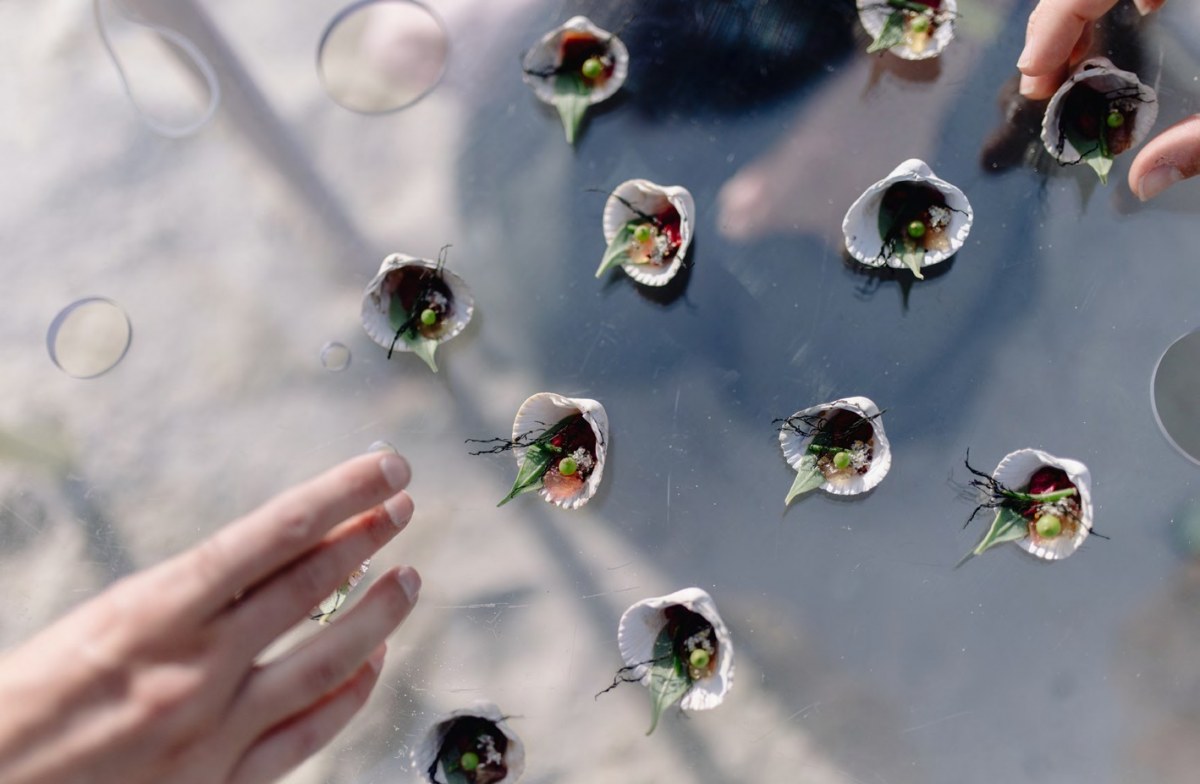
Instead of letting a sense of place be determined on an institutional level, we would rather literally sense a place from multiple perspectives. With the training we wanted to explore how to move together with the tides and all organisms of the local ecosystem. The tides show how there are many different temporalities moving simultaneously around us if we take a step back from regular ‘clock time’. The training started at a seemingly arbitrary time every day: 12:15, 13:30, 14:45… The difference with the evening and matinee slots of the other theatre shows at the festival was of course noticeable. We were completely at mercy of the low tide, so this time schedule could not be changed – the group adhered to the rhythm of the sea, not that of the land. Because OEROL is a performing arts festival, audience members are used to being a spectator, not a participant. Of course, being a participant is never truly a passive role: the presence of the spectator activates the performance as a whole. But being asked questions, being rendered vulnerable in a group of strangers, and working together to produce simple things such as movements or noise was not in the realm of expectation for many audience members at the festival. The goal of the training was not to create friction, but to find common grounds in creating a new language with all our senses. This took the spectator outside of the traditional ways of communicating: what happens when we listen together? Taste, smell, sing, breathe and move together? Most people become quite nervous when told they are to start a ‘training’. “Will I fail if I can’t keep up?” “Is it going to be strenuous?” “I haven’t practised or prepared anything!” This was a whole new way of practising accessibility. The audience needed to be welcomed to speculate, suggest and fantasise – something that not often happens in the presence of strangers. A question that came up a lot was whether this project was art, science, education, or all three. Aside from the assurance that de Onkruidenier is an artist collective, the question alone was a great result from the training. What if it were all three at the same time, what if all three were in fact the same for those one and a half hours?
On Terschelling, we looked for and found the elasticity of cultural and linguistic separations between land and sea, audience and performer, or body and landscape. Instead of explaining our idea of elasticity, we took nine sessions to train our audience in both their senses and their own cultural memory and language to explore this idea. Tangled together in elastics, we speculated on what a future of living with our seas might look, sound, or even taste like. What do you sense when you embody a landscape?
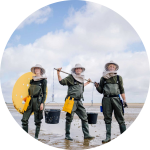
De Onkruidenier est un collectif d’artistes fondé en 2013, qui réunit actuellement Jonmar van Vlijmen, Rosanne van Wijk et Ronald Boer. Ces « futuristes de l’écosystème », comme il·elle·s aiment à se présenter, explorent – par le biais d’outils spéculatifs – différentes formes d’enchevêtrement avec notre espace de vie, révélant ainsi des interprétations possibles de la relation changeante entre l’humain et la nature. Au moyen de diverses méthodes artistiques et interactives, le collectif produit des œuvres ludiques et porteuses d’espoir écologique.



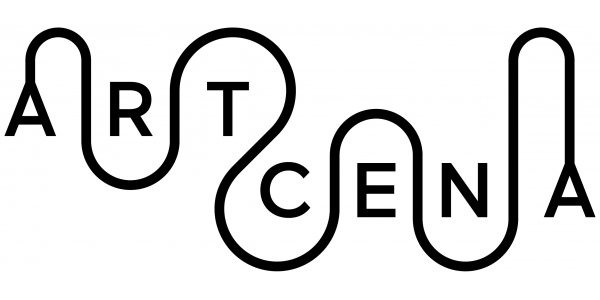

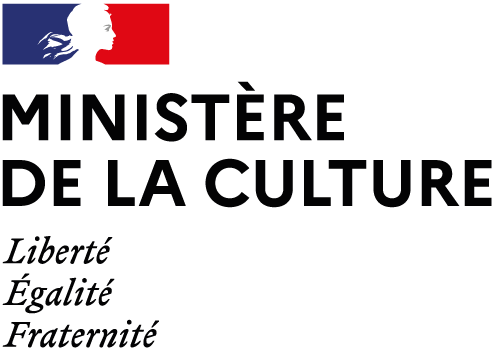
write us: infocircostrada@artcena.fr